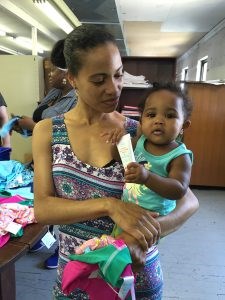By: Vanessa Penberg
With summer in full swing and temperatures getting progressively hotter, questions and concerns about how to best protect babies and children from sun exposure and insect bites arise. Strong evidence links early sun exposure to increased risk of children developing skin cancer later in life, even for darker-skinned children who may be less likely to burn. The rates of skin cancer have escalated to the point at which it is considered a public health risk.
As such, cities like Boston and Miami Beach are making sunscreen available for free in public places. New York City may be next. NYC Comptroller Scott Stringer recently proposed that a system of dispensers be installed at the city's parks, pools, and beaches which would provide free sunscreen. However, the specifics, including when the program would begin and how it would be paid for, have yet to be worked out.
In the interim, parents may feel overwhelmed by the variety of sun protection products available and keeping up with guidelines for their proper use. To complicate things further, recent reports about mosquito-borne viruses prompt concern among parents that they should be covering their children with insect repellant as well.
Dr. Perri Klass, NYU Professor of Pediatrics and Journalism and National Medical Director of Reach Out and Read (the New York affiliate of which is a Healthy Start Brooklyn partner), wrote a helpful post in The Check Up — Well Blog in The New York Times entitled "Sunscreen and Bug Spray: Children's Summer Skin Care" in which she provides answers and helps alleviate concerns.
Among some of the important take-away points are:

- Babies' delicate skin is more porous than adults' skin, so any chemicals that are applied may be more likely to be absorbed, and their immature organs may be less able to handle such chemicals. Parents of little babies are therefore advised to rely on reducing exposure by using shade and clothing for protection from the sun and adding screens and netting to keep the bugs off. Both the Food and Drug Administration and the American Academy of Pediatrics emphasize that babies under 6 months should be kept out of direct sunlight, protected with shade, and shielded with sunhats and protective clothing when they do have to be out, rather than relying on sunscreen.
- Since babies' skin surface is large in proportion to their body volume and their internal fluids, they are at high risk for heat and dehydration. Make sure they are drinking and wetting their diapers regularly.
- Sun hats and protective clothing are important for older babies and toddlers (dark colors and more tightly woven fabrics are proven to be more effective) as is avoiding sun exposure during the peak hours of 10 am to 2 pm.
- Parents should read labels carefully and not choose products by what is marketed for children or babies. The American Academy of Dermatology advises using products with an SPF of 30 or higher and making sure they are labeled as "water resistant" (lasting 40 minutes in the water) or "very water resistant" (lasting 80 minutes in the water) and "broad spectrum," which means they block UVA and UVB rays, both of which do damage. Dr. Klass emphasizes that there is no such thing as waterproof sunscreen.
-

- As for insect repellant, the majority contain either DEET, picaridin, or one of several essential plant oils, the most common on which is oil of lemon eucalyptus, as an active ingredient. The American Academy of Pediatricians recommends never applying DEET or any other insect repellant to children under 2 months (and no more than 30% DEET to older children) and avoiding oil of lemon eucalyptus for children under 3-years old. Most pediatricians suggest using all these substances sparingly on babies and young children; applying them only to exposed skin right before going outside; and washing them off with soap and water when coming back inside.
- Although products which combine sunscreen and insect repellants may be more convenient, they are not recommended since insect repellant does not need to be reapplied as frequently as sunscreen. The combination may, in fact, make the sunscreen less effective and increase children's chances of absorbing the chemicals. If more protection against insects is needed, apply insect repellent over sunscreen, and reapply the sunscreen after two hours on top of the insect repellent.
For more information, please read Dr. Klass' post in its entirety. Information on how adults may protect themselves from the sun, please refer to the UV Safety at the US Department of Health and Human Services website here.




